The mid-1990s were a mixed time for me. I had a fine house, a great job, a beautiful wife, and two lovely children—but I was boatless. My wife and I had sold our 32′ double-ender after our first child was born and we hadn’t found anything within our price range to take its place. So when yacht designer Nigel Irens was looking for guinea pigs to build a kit boat he and Ed Burnett had created, I jumped at the chance. It might not have been the oceangoing vessel I dreamed of owning, but it would at least get me back on the water. It would also mark a small personal milestone since, despite working as a journeyman shipwright for several years, I had never built a boat from scratch.
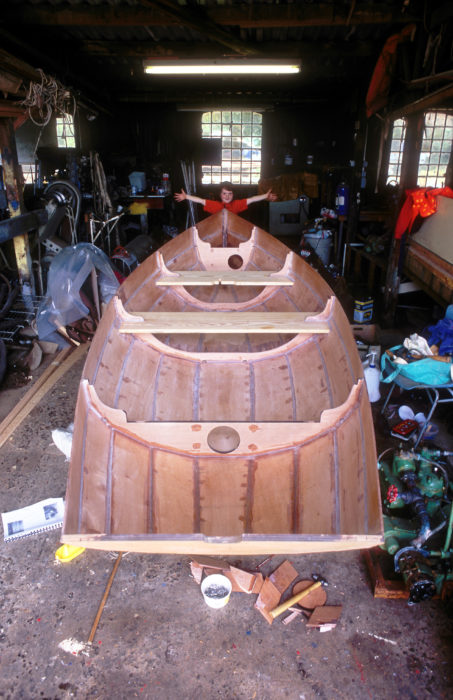 Salty Dog Media
Salty Dog MediaJune, 1997. Midway through building the skiff at the Lewes Rowing Club shed, just outside Brighton. That’s my oldest son Sam, then 5 years old (now 24, and quite a bit bigger than me), who helped with the build.
The Western Skiff, as Nigel called his new design, was a slender 14′ dinghy intended for rowing; it had a small lug rig to use as auxiliary power and an elegantly raked transom to discourage the use of an outboard. The kit—seven sheets of plywood for the boat and two sheets of MDF for the jig, all precut and ready to assemble, along with several gallons of epoxy and various interesting-looking powders—arrived in Cornwall where we were on holiday. My children—Zennor, 8, and Sam, 5—and I had great fun assembling the jig, using wedges to lock tenons in place. Getting the planks fair proved a bit trickier, but I managed to get the basic structure assembled in time to put it on a trailer and drive the 300 miles back to our home just outside Brighton, in East Sussex.
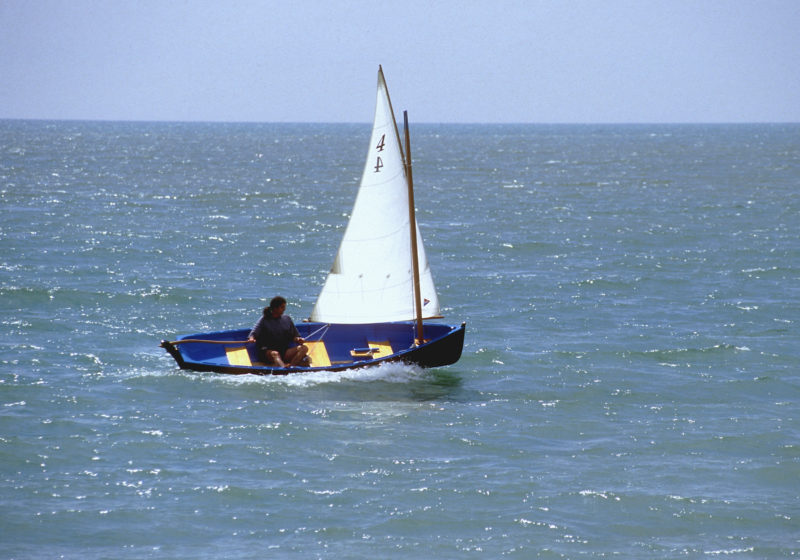 Salty Dog Media
Salty Dog MediaSeptember, 1997. We launched the skiff at Seaford Beach in East Sussex. It was an exhilarating first sail. I sat in the bottom of the boat, as the designer had recommended, to keep my weight low. The first outing couldn’t have been better—apart from nearly breaking a friend’s leg when a big wave dumped the skiff in his lap.
It took all my spare time plus two weeks’ holiday spread over four months to complete the skiff, but finally in July 1997 we launched her in the azure waters off Seaford beach. There was a brisk onshore breeze blowing, which created a small surf, and within minutes the boat was flung into the lap of a friend who had come to help launch her. The boat still bears a scar from that incident, as no doubt does he. But that breeze also showed me how fast the skiff could go under sail; I had an exhilarating couple of hours tacking up and down the 2-mile-long beach. As you might expect of a dinghy primarily designed for rowing, she was extremely tender under sail, and even with her modest 61-sq-ft balanced lugsail, she would capsize in a thrice if you didn’t ease the sheet in time. But that was all part of the excitement, and I immediately felt very comfortable with the boat, as if we had struck a personal rapport.
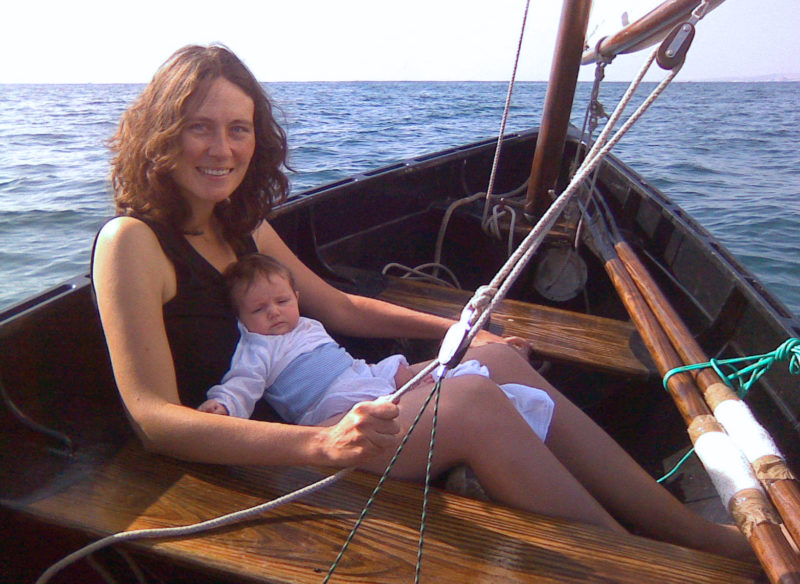 Nic Compton
Nic ComptonSeptember, 2009. My wife-to-be Anna and I took a rare foray off Brighton beach with our daughter Betty, who was about 4 weeks old when this picture was taken. We had repainted the skiff black and varnished the thwarts, which had previously had been just oiled, for a slightly ironic piratical look. The trouble was that no one got the joke.
After the initial sail off Seaford, I kept her on a trailer at a rowing club on the river Ouse, in Sussex, with occasional trips rowing upriver to Hamsey or sailing downriver to Newhaven. My kids loved those forays upstream, and their evident pride as they steered the boat past familiar landmarks made me glad I could pass on a tiny piece of my boating life to them. On the downstream trips, I learned to “shoot” the bridges by lowering the mast on the approach and raising it on the other side. The one time I forgot, the almighty crash of wooden spar against stone wall made sure I never forgot again. Miraculously there was no damage.
Despite being only 14′ long, the skiff could be a sociable boat, and the 90-minute trip to Newhaven was an opportunity to cement friendships. On one occasion a friend astonished me by pulling a flask and china cups out of his rucksack and proceeding to pour us both a cup of tea. It doesn’t get much more English than that.
Over the years, I tried giving the skiff a proper name. First she was HARA, Greek for joy and the name of a favorite haunt when I was child growing up in Greece. Then I decided to go ultra-traditional and named her SALLY, after my mother. But somehow neither name stuck, and I’ve always simply referred to her as “the skiff.” It’s taken me nearly 20 years to realize that I don’t need to force a name onto her and that “the skiff” is perfectly good, full of romantic connotations and richly evocative in its own right.
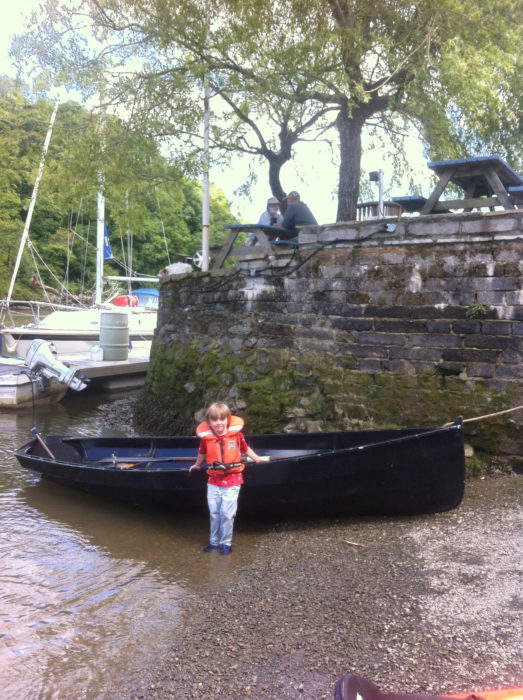 Nic Compton
Nic ComptonJuly 2015. Two days after we moved to Devon we rowed to the Maltsters Pub, once the haunt of UK celebrity chef Keith Floyd. My son Sol was just 5 days shy of his 4th birthday.
Three years after the skiff was launched, I was divorced and living alone on an old 12-ton cutter in nearby Newhaven. Between the heaps of scrap metal and the depressing housing estates, I had a small oasis in the muddy creek where I moored my yacht. Here, the skiff was moored alongside and when I came home from work, if the tide was up, I went for long rows, lit up by the lights of the ferry terminal. In the summer, friends visited and we would sail upstream and bathe in the river. After sitting in front of a computer all week, the skiff provided true solace.
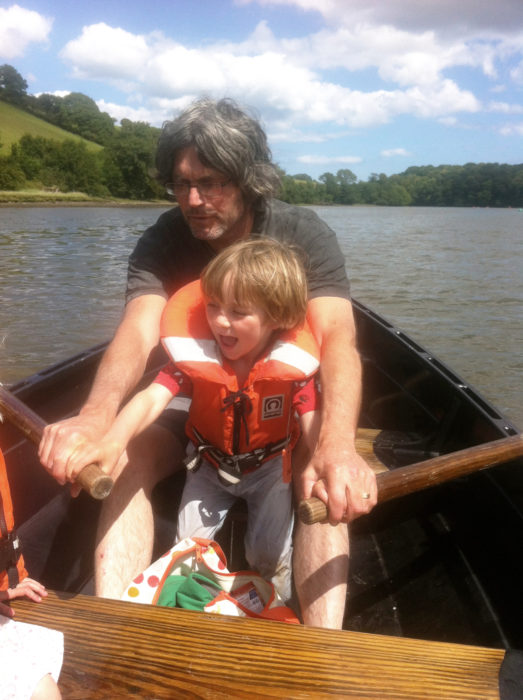 Anna Compton
Anna ComptonJuly 2015. As we were heading down the exquisite Bow Creek on the River Dart, just a mile or so away from our new home, I started teaching Sol to row. The skiff has been a perfect way for me to pass on my love of boating to my kids.
After eight years living on my own up a muddy creek, I decided to sell my cutter and buy a flat in trendy Brighton. For a while, I kept the skiff on the beach, with a plywood cover to keep intruders out, and launched her for the occasional row or sail. But Brighton is a better place for partying than boating, and I have to admit the skiff entered into a period of neglect as I made the most of being a bachelor again. When I discovered part of the plywood lid had been ripped off and used for a beach fire, I decided to put her back on her trailer and keep her, for want of anywhere better, in a friend’s garden. Over the next few years, I parked her wherever I could and, as the cover I’d put over the boat deteriorated, the neglect deepened and so did my guilt.
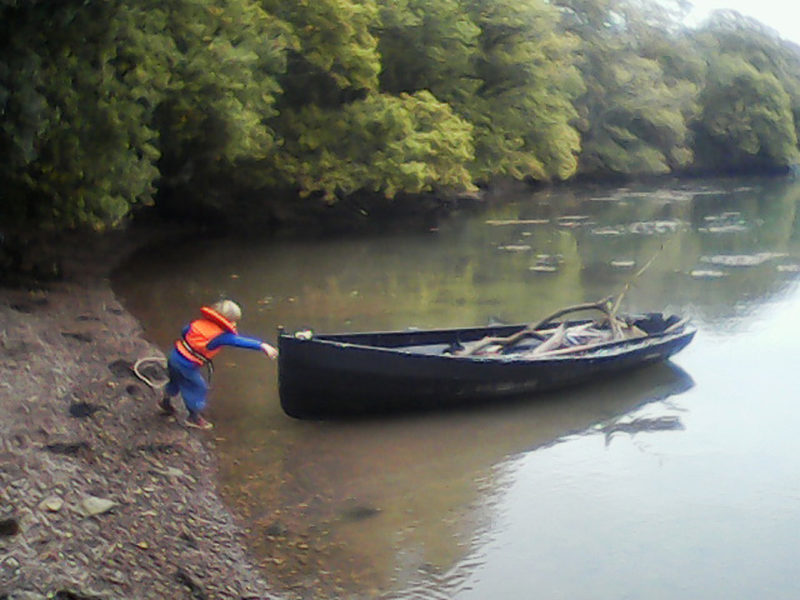 Nic Compton
Nic ComptonOctober, 2015. It rained solidly for a month after we moved and, as our house hadn’t been lived in for more than a year, it was extremely cold. Sol and I made weekly trips with the skiff to collect firewood.
Then I met my Anna and two years later we had a lovely daughter—Betty, now aged 7—and then a lovely son—Sol, now 5—and the skiff fell further down my list of priorities. Soon after meeting Anna, in the first flush of optimism, we made one half-hearted attempt at cutting out some of the rot and repainting her, but sailing from Brighton was just too little return for so much effort. As the bills piled up, I thought about selling the skiff, but I always had a feeling that our circumstances might change, and that somehow she might become the ideal boat once again. Or, to put it another way, I always knew that if the skiff didn’t have a place in my life, that probably meant I was probably not leading the right life, and when the balance was redressed she would regain her rightful place.
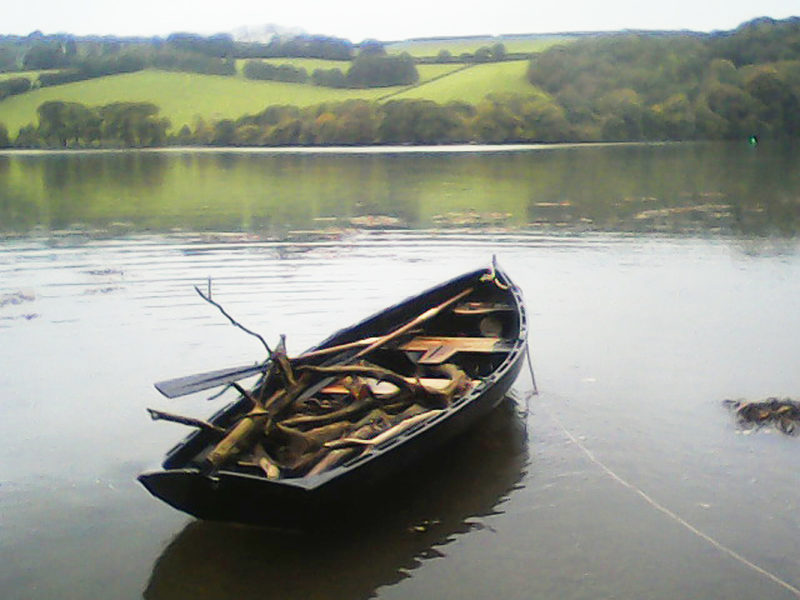 Nic Compton
Nic ComptonOctober, 2015. The firewood we gathered was mostly the local oak which had “seasoned” while floating in the river. Once it had dried out it burned perfectly.
Not everyone shared my despair. Our neighbors told us that far from finding the sodden hulk parked opposite their front door a nuisance, they enjoyed having her there and thought she added character to the neighborhood. Another friend expressed the same sentiment when I parked the skiff in her front drive where it became an object of curiosity for visitors, who could always be sure of finding “the house with the boat outside” in a row of nearly identical modern houses. Even in her deteriorated state, it seemed, the skiff could still bring pleasure, and I couldn’t help feeling a glimmer of pride.
Eventually Anna and I could take city life no more, and in July 2015 we upped sticks and moved to a beautiful village on the River Dart, in Devon. Straightaway, we launched the skiff in the tidal estuary that flowed within sight of our bedroom. She proved an ideal boat for exploring our new environment, and for the first six months we went out almost every week, either rowing to nearby pubs or collecting driftwood off the nearby beaches to chop up into firewood. The only limitation was that, while most of the other families we met had boats with outboards and could happily nip up and down the river at almost any state of the tide, we were limited by how far we could row, which, with two adults, two children, and (eventually) a dog on board, wasn’t all that far.
We left the skiff on the jetty that autumn, and by winter’s end she looked in a very sorry state. The rot at the ends of the thwarts had spread because the drainage channels there had a tendency to get blocked up. And when I turned her over I found gribbles had wormed their way into the keel.
The skiff, to my eyes, was still the exciting lightweight rowing dinghy, the legendary Nigel Irens design that I had built with my own hands all those years before. She had stood by me in good times and bad, and still gave me a thrill riding the little wave that built up on the stern quarter when the wind clashed with the outgoing tide. But to most other people she must have just looked like a sad old wreck.
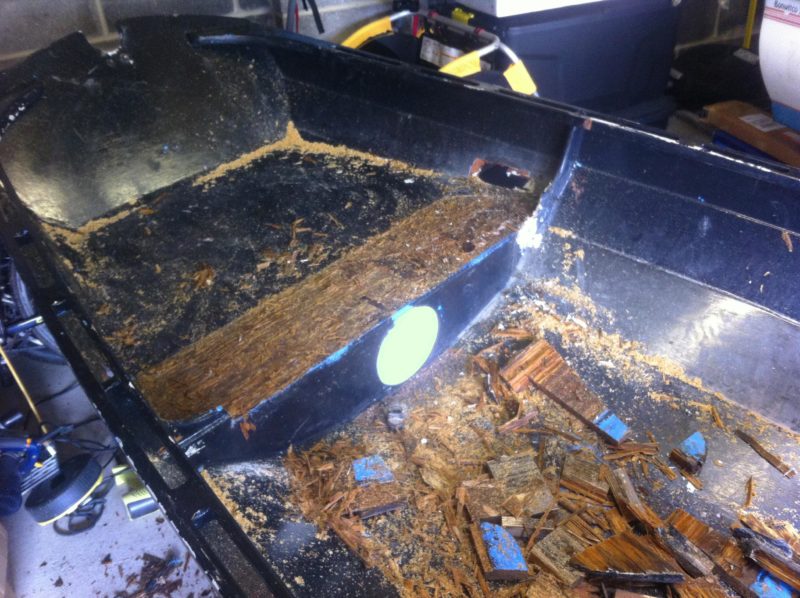 Nic Compton
Nic ComptonMarch, 2016. My poor neglected skiff. Nearly 19 years after being launched, the fore and aft thwarts were rotted away where the drains at either end got blocked. The damage spread into neighboring bits of plywood.
I decided to take her out for a major overhaul, and began to think the unthinkable. What if we fitted an outboard on her, in spite of the transom meant to prevent that? The very idea had always been an anathema to me, but I began to see that if we put a well through the aft buoyancy tank, it needn’t be intrusive or detract from her performance under sail and oar. I consulted with Nigel and, to my surprise, he was very relaxed about the idea. He agreed that a well was the way to go, and even suggested the outboard could be positioned on the centerline if I were to cut out the aft end of the keel.
The refurbishment, as often happens, turned out to be more extensive than I had expected. I replaced both the forward and the aft thwarts, and cut out and patched new sections of planking and bulkheads where the moisture had spread into the plywood. I repainted inside and out and made a couple of important upgrades for her new life on the river: a rope fender around the bulwarks to protect her when coming alongside docks and brass strips on the keel and bilges to take the brunt of being dragged up and down beaches. The overall effect was pretty dramatic and made me look at her with renewed affection—like when the one you love dresses up for a party and you see her as if for the first time again.
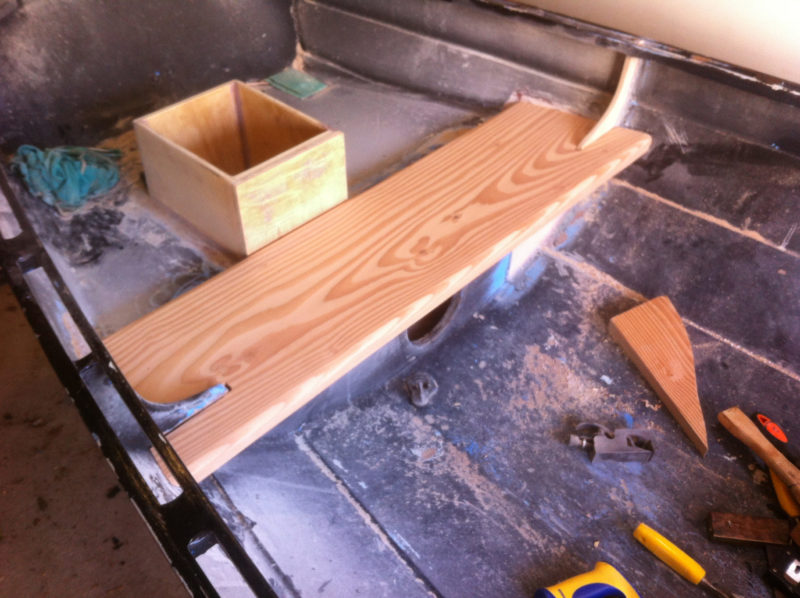 Nic Compton
Nic ComptonApril, 2016. I fitted a new thwart made from some locally sourced Douglas fir. I made the drains much bigger this time and sealed the thwart’s end grain with epoxy. I built the plywood outboard well to the side of the centerline.
As for the outboard well, I couldn’t bring myself to cut the keel and instead made the smallest well possible directly next to it on the starboard side. The well itself was made out of 12mm marine ply, with three layers on the forward side, lapped over the new stern thwart to spread the load of the outboard. I shaped the hole through the hull to the dimensions of the propeller and skeg, and used the cutout to make a lid to close the hole while under oar or sail.
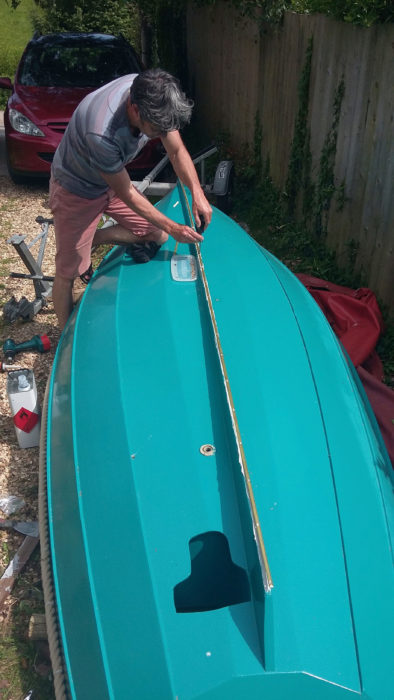 Zennor Compton
Zennor ComptonJune, 2016. We were constantly dragged the boat up and down shingle beaches, so fitting a brass keel band was an absolute necessity and one of the best things I’ve done for the boat’s longevity. The outboard well’s aperture is shaped for the motor’s lower unit and propeller. I kept the cut-out to make a lid which fits into the hole from the inside; it reduces the drag and noise while I’m rowing.
We relaunched the skiff at the beginning of June of this year, and the effects were immediate and dramatic: “A life-changer,” as my neighbor put it. The outboard conversion was a great success, performing far better than I had expected. Even laden down with the whole family, including dog and picnic, she nipped along at quarter-throttle under her new 3.5-hp engine.
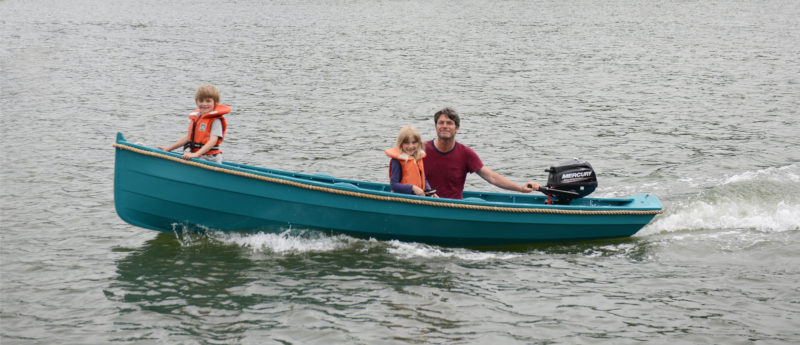 Zennor Compton
Zennor ComptonJune, 2016. During the trials with the new engine, it was obvious that the tilt was wrong and pushed the bow up. I had made the outboard well parallel with the aft bulkhead, but it clearly not vertical. I’ve since added a couple of wooden shims to adjust the angle. I’ve also borrowed an outboard extension so I can sit on the middle thwart and put my weight farther forward. The 3.5-hp outboard was bigger than we needed; a smaller, lighter 2.5 hp would have provided plenty of power.
The river suddenly opened up to us. Before, we had been confined to rowing only a mile or two upstream or downstream; we now had the run of the whole river, and beyond. Using the tide to our advantage we sped 4 miles upriver to Totnes in half an hour and 5 miles downriver to Dartmouth in 40 minutes. For the first time since coming to the village, we headed out to the open sea to explore the spectacular Mew Rock, now just an hour away. Even more importantly, perhaps, the skiff has embedded us in the local community, allowing us to join social events on the river that would have been out of reach before.
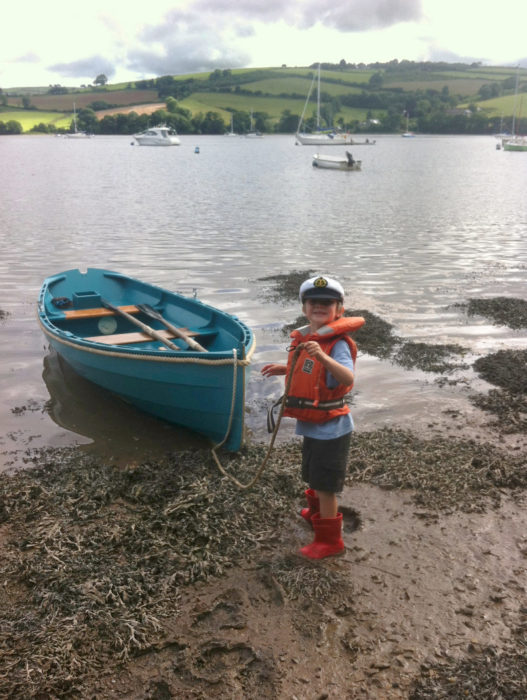 Zennor Compton
Zennor ComptonJune, 2016. Sol got dressed up for our first trip with the reborn skiff after restoration. We launched from a shingle beach just around the corner from our home.
The skiff is still a joy to row, and the outboard, quite unexpectedly, has made her even more so. Because the skiff is so light, Nigel always used to recommend carrying a couple of jerry cans of water as ballast to give the boat more momentum when I was rowing alone. Now, the outboard does that job. When not in use, it fits snugly next to the centerboard case and provides the ideal extra weight in just the right place.
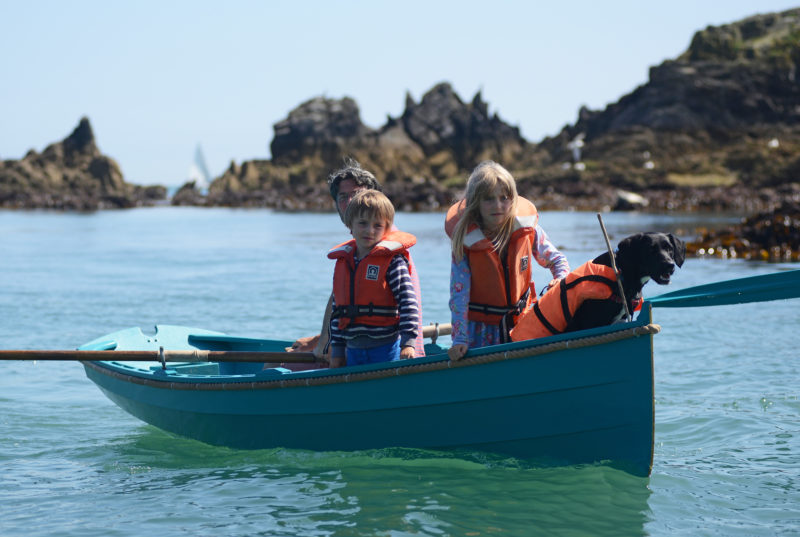 Zennor Compton
Zennor ComptonJuly, 2016. The skiff is ideal for outings with Sol, Betty and our dog, Winnie. Any more than that, the ride gets a bit wet.
In due course, I intend to rerig the skiff to teach my kids to sail, so she still has potential waiting to be unlocked. But, in the meantime, there’s no doubt that the outboard has breathed new life into old bones and brought the skiff back into our lives as a much-loved member of the family. And it’s not just in my head this time, as friends and strangers now tell me how good she looks, and one person even asked to buy her. Although few had noticed what an amazing boat she was all along—after all, what’s a coat of paint?—I can’t help but feel immensely proud of her.
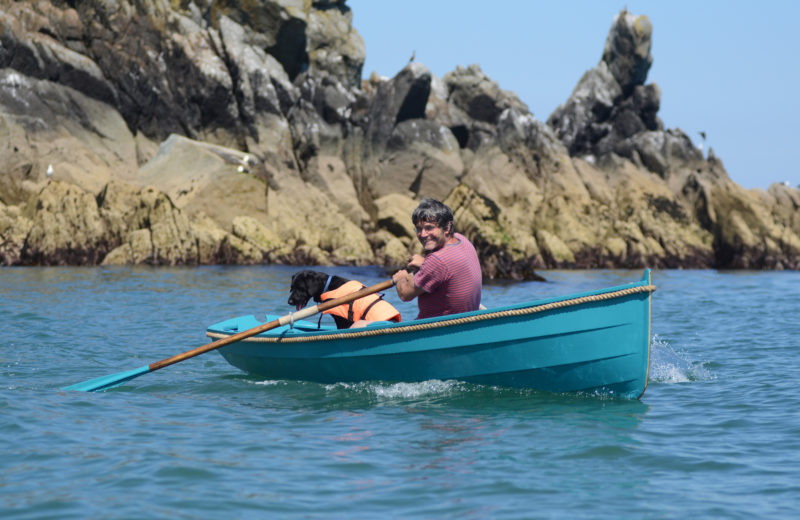 Zennor Compton
Zennor ComptonJuly, 2016. With a lid covering the outboard hole and the outboard itself providing ballast forward, the skiff rows better than ever. Just outside Dartmouth we usually see ten or twelve seals whenever we go to the Mew Stone.
Since I built the skiff, I’ve owned three yachts, ranging from 25′ to 36′. But while the bigger boats have come and gone, the skiff has remained constant, and my appreciation of her has deepened. And, in unexpected ways, she has acted as a kind of compass, pointing me to the kind of life I want to lead.![]()
Nic Compton is a freelance writer/photographer who grew up sailing dinghies in Greece. He has written about boats and the sea for more than 20 years and has published 12 nautical books, including a biography of the designer Iain Oughtred. He currently lives on the River Dart in Devon, U.K., and owns two boats designed by Nigel Irens.
If you have an interesting story to tell about your adventures with a small wooden boat, please email us a brief outline and a few photos.
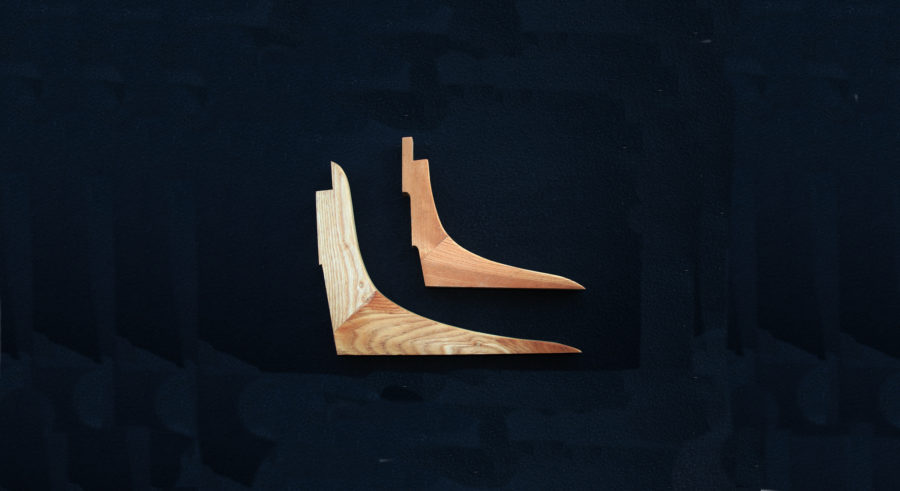
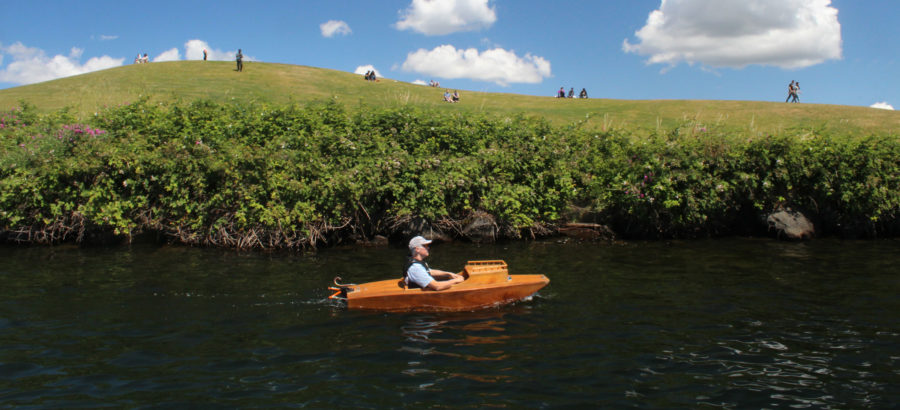
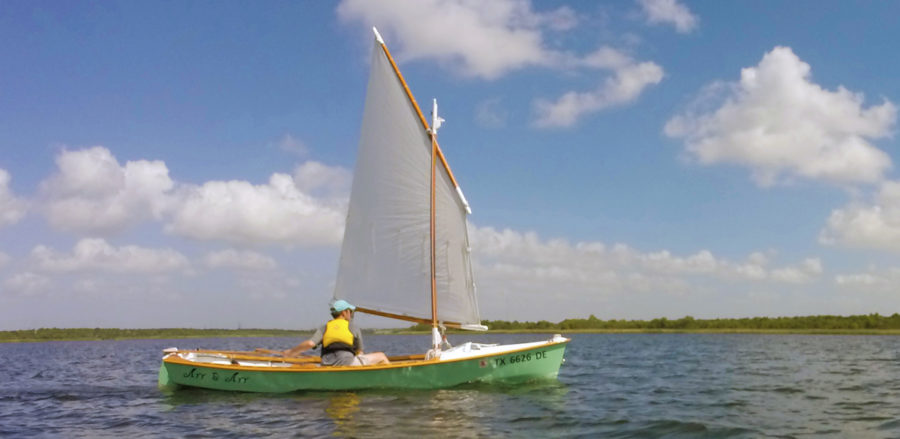
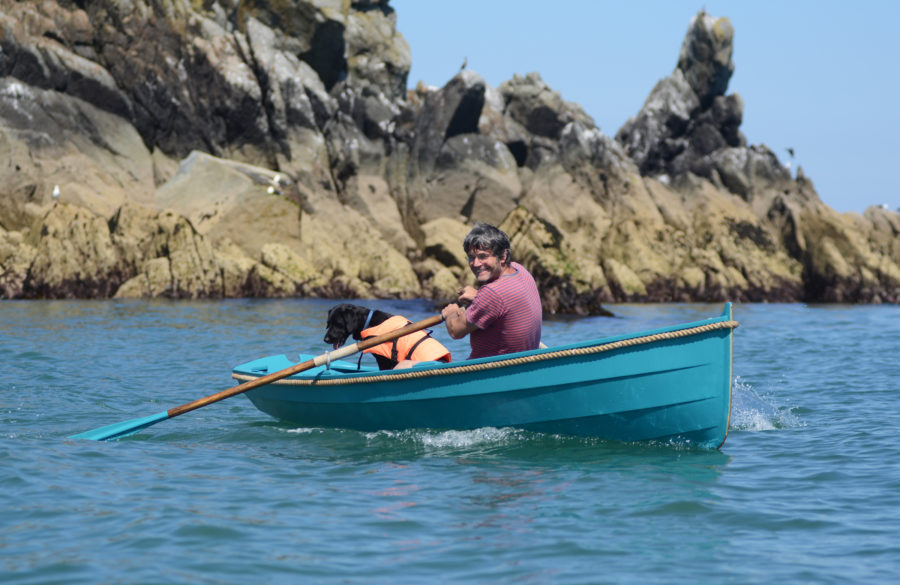
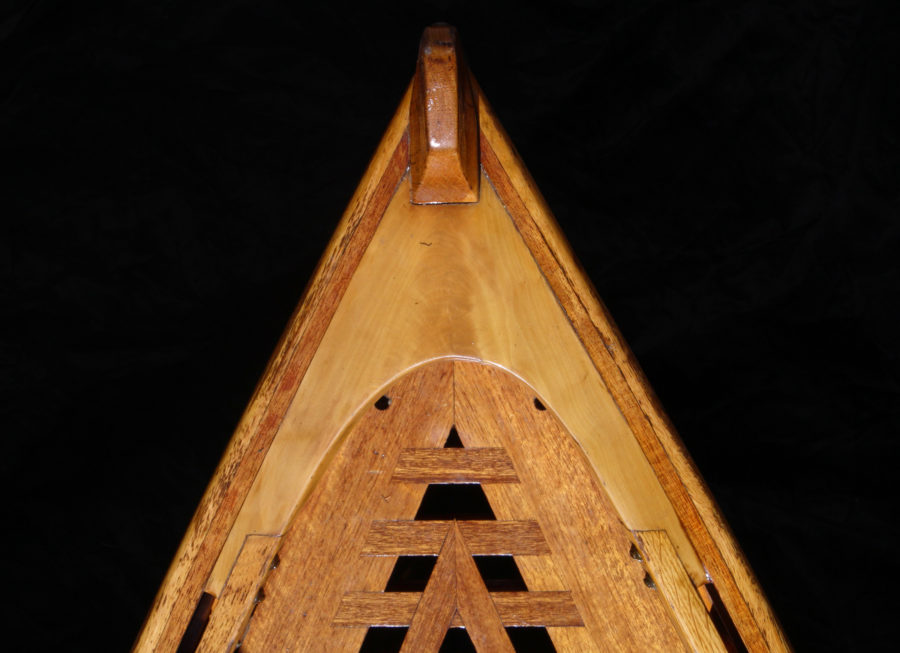
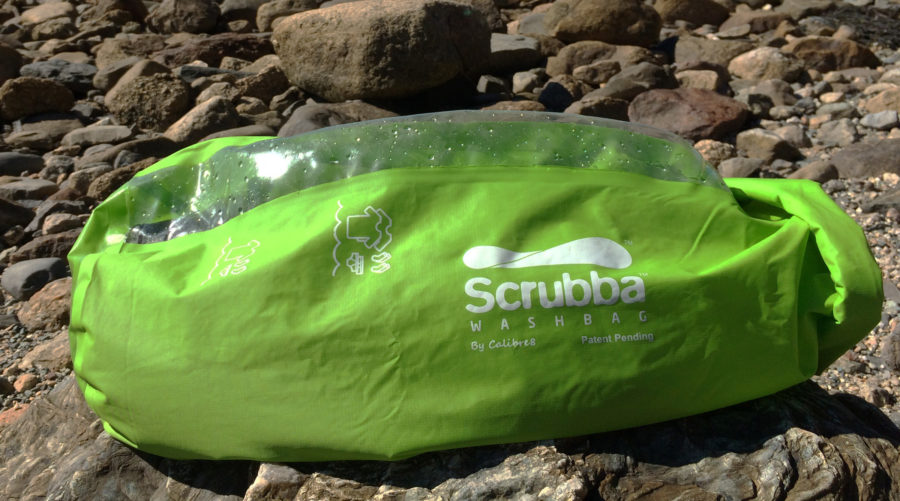
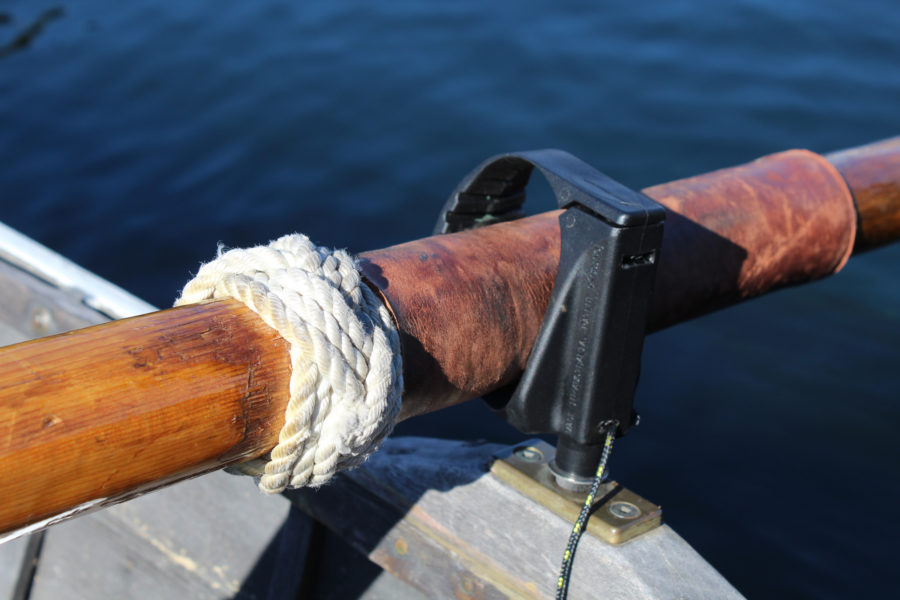
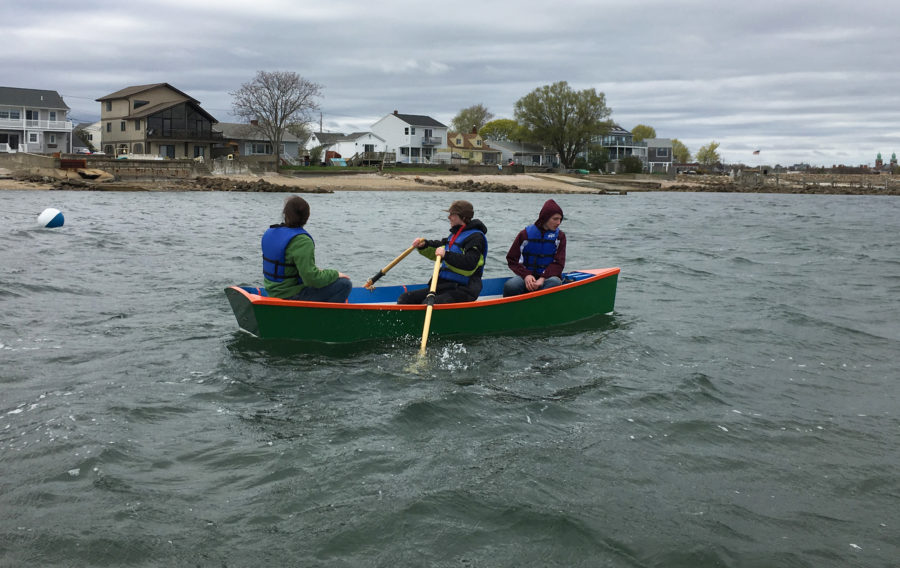
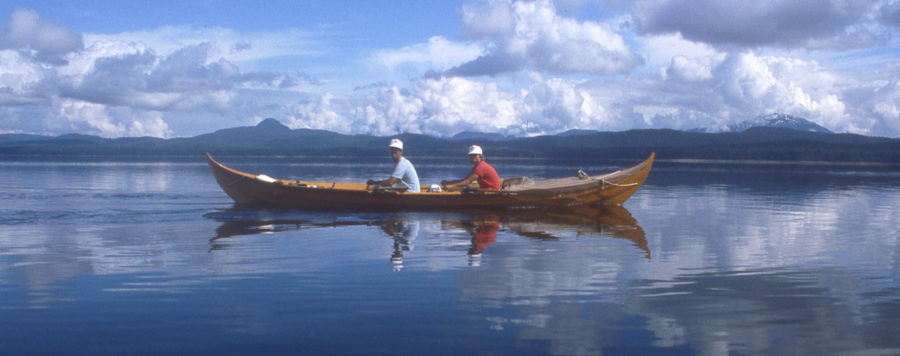
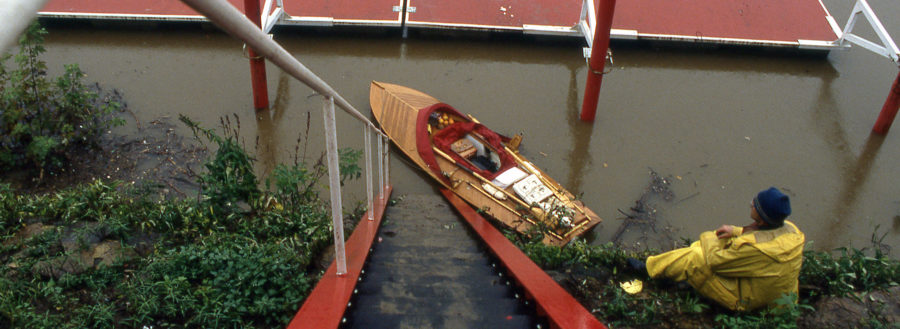

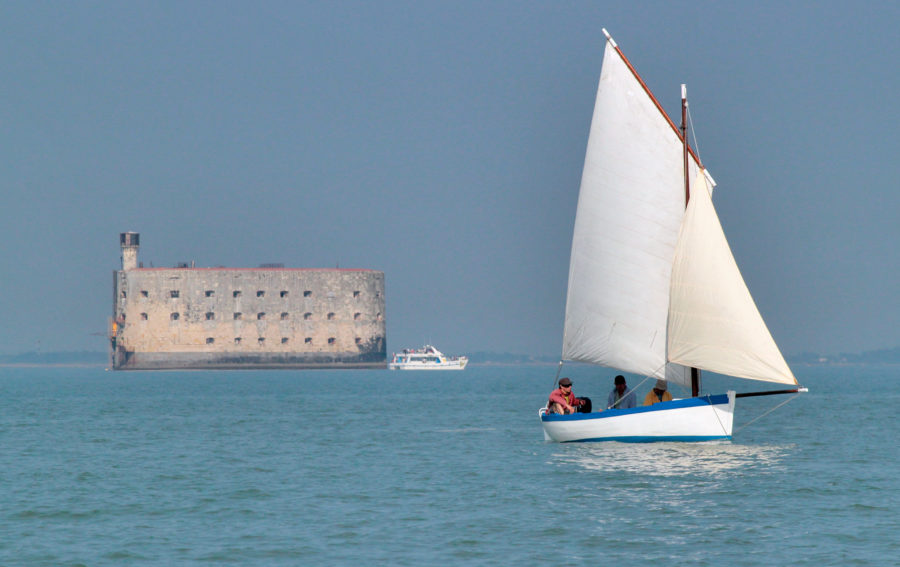
WoodenBoat has opened a can of worms with this piece as many readers will want to build this boat after seeing it. She is a gorgeous little design – perfect size and proportions. Please negotiate with Nigel Irens to publish and sell the plans!
Excellent idea, Alan. Please WoodenBoat, publish these plans and maybe offer the kit!
Great idea: I saw the boat first on the first Raid in Portugal on the river Douro. She impressed me with her speed with that small sail and also the clever construction, a combination of stitch and glue, where it protects the boat from scratches, and lapstrake above the waterline where good looks count. I think it is a great boat for a kit. Who is going to press Nigel Irens into action?
A four-week-old child in a small sail boat out on a sea…NO LIFEJACKET! The mother of this child…NO LIFEJACKET! Get real!!!
As a father and grandfather I find this totally unacceptable and why would WoodenBoat magazine publish a picture like this?
Thanks for raising the issue of safety on the water. We do take it seriously. That family photo was not intended to condone boating with a child without a lifejacket. We published the photo because it shows an important moment in the author’s life and a pivotal time for the story about his boat. The children are wearing lifejackets in the rest of the photos, afloat and ashore, and even the dog is wearing a lifejacket. The author offers this: “There’s no legal requirement in the UK for anyone to wear a lifejacket. The onus is on the skipper to ensure everyone is wearing one. In this case, we were sailing within 100ft of a beach in shallow water, so I didn’t consider it necessary. Would I do it again? Probably not.”
Thanks for reading, Kerr, and thanks for bringing safety to the fore.
Anne Bryant, Associate Editor, WoodenBoat
Nic, I think you’ll find the outboard tilt was not the cause of the boat’s poor trim under power. Even with the motor perfectly set up, the hull could not be expected to trim properly at that speed, given her buttock lines.
My choice of motor would be (2-stroke) a Yamaha 2hp weighing 9.8kg (21.6 lbs), or (4-stroke) a Honda 2.3hp at 12.5kg (27.5 lbs). My old Honda, from the days when they were rated at 2hp, has given thirteen years of steling service on many boats. On Flint (reviewed elsewhere in this issue) the old Honda requires only about half-throttle to bring the boat up to a semi-displacement speed.
I have just read your excellent article “A Man’s Best Friend.” I thought it might interest you how building a boat has led to a real family interest in boats and woodworking, where none existed before.
It began when we were living in Bermuda and my second son insisted that he and I build a boat as opposed to me simply buying him one. As a busy lawyer in an international legal firm I neither had the time nor experience to build a boat, so I was very reluctant. But my then 10-year-old persisted and eventually was successful. My wife was keen as well as it was a good opportunity for us to spend time together. How right she was. It birthed a real passion in building boats for me—I have now built two boats and currently building a Jericho Bay skiff—but also it was a fantastic experience and time together for two of my sons. It also inspired my son to do a module in his high-school exams on industrial timber and design. His skills now well exceed mine and he is very much going to be a big part of building the Jericho Bay skiff.
My eldest son—now 20 and in medical school—not wishing to be ignored, is pushing me to build with him the Pathfinder by John Welsford. He fancies sailing in Sydney Harbor. where we now live.
So what started as a nagging insistence by my middle son has spawned an interest in both me and my other sons.
I don’t know who has the plans these days; although I have yet to build the boat, I got a full set of plans for the Western Skiff from Ed Burnett shortly before his death. She’s a lovely boat, and it’s hard to choose between her and an Acorn.
I, myself, am building a 12′ Acorn skiff. Have made all the laminating jigs, patterns for the various pieces, cut and splined my mahogany for the transom, cut the wood for the keel, now I need to go buy the epoxy and plywood for the hull. I am excited! I grew up on the Hudson river in Stillwater, New York. Been to Long Island many times on my Dad’s boat, lots of great times. I have a 17′ MacGreggor sailboat I love to sail on Saratoga Lake nearby.